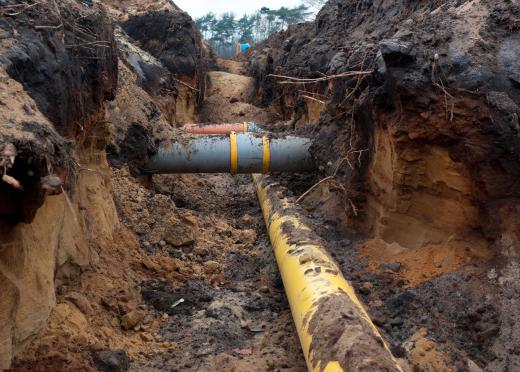A cast iron pipe is a metal pipe made by melting pig iron along with substantial quantities of scrap iron and metal and casting it in a mold. It usually carries sewage and waste water and is also used for venting and the transportation of drinking water. Cast iron pipe comes in eight classes, A through H, rated in increments of 100 feet of head (30 meters of head), which is the measure of pressure generated by a given height of water. One foot of head is equal to 0.434 psi (305 kg/sq m).
While cast iron was invented in China in the fourth century B.C., it was not used for piping until much later. The first documented cast iron pipe was laid in Germany around 1455 and the French laid a network of cast iron pipe to supply water to the City of Versailles in the 1600s. In 1804, Philadelphia became the first city in the United States to use cast iron pipe for water. Although it is not used for water transport as widely as materials like copper, cast iron pipe continues to be used in sewage and waste lines worldwide. Larger cities in Europe and the United States contain thousands of kilometers of cast iron pipe, many of which have been in service for over 100 years.

There are two varieties of cast iron soil pipe, each with distinctive joining methods. Hubless pipes do not have the hub, allowing a coupling to be fitted onto the straight ends of the pipe. The joint can then be tightened to create a seal. The other variety are hub and spigot pipes, whose fittings are unique. In this format, the spigot, or straight end, of one pipe is made to fits into the hub of another. A compression gasket usually made of rubber is used to seal this joint.

Early methods of manufacturing cast iron pipe by forming it in horizontal and vertical molds gave way to the deLavaud centrifugal process in the early 1900s. To complete this process, a mold is set spinning while the molten metal is slowly poured in and then cooled with water. Ductile iron pipes, invented in 1948, are manufactured by a similar process, but with the addition of trace amounts of magnesium or cerium to create a stronger, more flexible metal. They have largely superseded cast iron pipe for use in new water and sewage lines. Ductile iron pipes have flanges that are threaded or welded onto the ends of the pipes and are joined by mating the flanges and connecting them with bolts.
